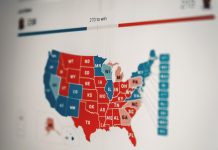The Supreme Court ramped up Republican voter suppression tactics on Monday when it decided in a split 5-4 decision along partisan lines to permit Ohio’s system for stripping voters from the rolls to proceed.
In Ohio, registered voters who have not voted for two years are mailed prepaid postcards to ascertain their addresses. If that card is not returned and voters do not vote for four more years, they are purged from the rolls, forcing them to either re-register or be permanently disenfranchised.
This practice’s opponents cite a flagrant violation of the 1993 National Voter Registration Act (NVRA), or the “Motor Voter Act,” and the 2002 Help America Vote Act (HAVA), which prohibit states from removing voters from rolls because they choose not to vote.
The high court’s Husted v. A. Philip Randolph Institute ruling on Monday concludes otherwise, stating that although Ohio uses voters’ absence as its initial impetus to begin the purge process, their failure to return the postcard “proves” they warrant removal. Failure to vote by itself is not, according to the ruling, the reason they are removed.
Justice Samuel Alito stated in his majority opinion:
“The dissents have a policy disagreement, not just with Ohio, but with Congress. But this case presents a question of statutory interpretation, not a question of policy. We have no authority to second-guess Congress or to decide whether Ohio’s Supplemental Process is the ideal method for keeping its voting rolls up to date. The only question before us is whether it violates federal law. It does not.”
The Court–minus the four progressive justices–found:
“Ohio’s process cannot be unreasonable because it uses the change-of-residence evidence that Congress said it could: the failure to send back a notice coupled with the failure to vote for the requisite period. Ohio’s process is accordingly lawful.”
Justice Sonia Sotomayor noted in her dissent that Congress passed the Motor Voter law because of historically restrictive registration procedures and purge rules designed to suppress votes.
An example Sotomayor provided was from Hamilton County, Ohio, where “African-American-majority neighborhoods in downtown Cincinnati had 10% of their voters removed due to inactivity” since 2012, as “compared to only 4% of voters in a suburban, majority-white neighborhood.”
She also cited amicus briefs that explain:
“At length how low voter turnout rates, language-access problems, mail delivery issues, inflexible work schedules, and transportation issues, among other obstacles, make it more difficult for many minority, low-income, disabled, homeless, and veteran voters to cast a ballot or return a notice, rendering them particularly vulnerable to unwarranted removal under [Ohio’s rules].”
Sotomayor argued that another provision of the Motor Voter law requires voter purge programs “be uniform, nondiscriminatory, and in compliance with the Voting Rights Act (VRA).”
In his dissent, Justice Stephen Breyer claimed Ohio relies too much on voters’ failure to respond to their notices, writing:
“A forwardable notice that elicits no response whatsoever tells the State close to nothing at all. Ohio’s system adds to its non-voting-based identification system a factor that has no tendency to reveal accurately whether the registered voter has changed residences. Nothing plus one is still one. To add an irrelevant factor to a failure to vote, say, a factor like having gone on vacation or having eaten too large a meal, cannot change Ohio’s sole use of ‘failure to vote’ into something it is not.”
Stuart Naifeh, senior counsel at Demos, which led the legal team challenging Ohio’s practices, stated:
“The fight does not stop here. If states take today’s decision as a sign that they can be even more reckless and kick eligible voters off the rolls, we will fight back in the courts, the legislatures, and with our community partners across the country.”
Ten years ago the Republican party was licking its wounds after the country elected its first African American president and Democrats controlled both houses of Congress.
So Republicans came up with a strategy: concentrate on 16 states and gerrymander them so badly Democrats have little to no mathematical chance of winning in the 2010 mid-term elections.
But there was another, more insidious strategy.
Republicans knew they couldn’t come right out and criminalize voting, so they devised ways to make casting ballots harder, more inconvenient, frustrating, hoping people would stay home rather than go through all the trouble to practice their civic duty.
That’s when the term “voter fraud” started circulating around right-wing media. Simply accuse random people (mostly immigrants) of voting illegally, and enough “patriots” would rise up in an altruistic fervor to fortify the most fundamental of democratic institutions against those who seek to denigrate it. Some (Republican) states began instituting “voter I.D.” laws, requiring birth certificates, drivers’ licenses, passports, for the right to vote. After all, minorities vote primarily for Democrats. If they are to preserve their hegemony, Republicans must take evasive measures.
Voter fraud, however, is a myth. Just look at the evidence.
Voter suppression, though, is very much alive, and this week’s Supreme Court case regarding Ohio is sure to open the floodgates just in time for November mid-term elections.
Image credit: USA Today





